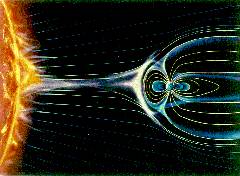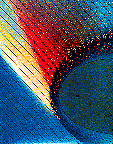Although one often hears of the vast emptiness of space, the universe outside our world is in fact filled with a gas of electrically charged particles called a plasma. For instance, our sun, the source of light and heat that fills our world, is also the source for a high speed wind of ions and electrons that we call the solar wind. At the Earth's orbit, the velocity of this wind is approximately ten times the speed of sound, or about 450 km/s (over 1 million miles/hr). Admittedly, this gas is rarified with a density of approximately 10 protons per cubic centimeter near Earth. This high speed gas fills the solar system and creates a bubble which excludes the similar gas of the interstellar region.
 The planets
orbit the sun at a relatively slow speed, but the solar wind blows past
the planets at a high speed. The relative motion of the planet through
this wind is similar to a high speed aircraft flying greater than the
speed of sound, and a shock forms around the planet much like the shock
wave that forms around an supersonic airplane. Due to the fact that this
is a gas of charged particles, a variety of new physics is possible. We
call this shock the planetary bow shock. The purpose of this project is
to study this shock as it forms around the planet Saturn.
The planets
orbit the sun at a relatively slow speed, but the solar wind blows past
the planets at a high speed. The relative motion of the planet through
this wind is similar to a high speed aircraft flying greater than the
speed of sound, and a shock forms around the planet much like the shock
wave that forms around an supersonic airplane. Due to the fact that this
is a gas of charged particles, a variety of new physics is possible. We
call this shock the planetary bow shock. The purpose of this project is
to study this shock as it forms around the planet Saturn.
In September 1977, NASA launched two spacecraft named Voyager 1 and Voyager 2 whose mission was to study the planets Jupiter and Saturn. Voyager 1 reached Saturn in the late 1980s while Voyager 2 trailed behind reaching Saturn in 1981. Since that time the spacecraft have continued to study the vast bubble of the sun's influence that we call the heliosphere, while Voyager 1 has become the most distant man made object in our universe. These robotic spacecraft are equipped with a suite of scientific instruments designed to study the plasma gas, the magnetic field of interplanetary space, and energetic particles including cosmic rays in addition to taking photographs of the planets.
 Planetary bow
shocks accelerate charged particles using a variety of mechanisms that might
loosely be compared to simple reflection. Among these particles are energetic
electrons. Although the Voyagers are not equipped to measure beams of
energetic electrons of the type produced by planetary bow shocks, they are
equipped to measure the electrostatic waves produced by the electrons. We
can use these waves to determine when the local magnetic field at the location
of the spacecraft is connected to the bow shock, and in particular we can use
these waves to determine when the connection geometry is tangential with the
magnetic field line just touching the shock but not crossing it (in an
idealized theory). With this information, the location of the spacecraft and
the observed range of magnetic field directions, the students here at
the Charter School can map the shape and location of Saturn's bow shock
as it moves and changes shape under changing solar wind conditions.
Planetary bow
shocks accelerate charged particles using a variety of mechanisms that might
loosely be compared to simple reflection. Among these particles are energetic
electrons. Although the Voyagers are not equipped to measure beams of
energetic electrons of the type produced by planetary bow shocks, they are
equipped to measure the electrostatic waves produced by the electrons. We
can use these waves to determine when the local magnetic field at the location
of the spacecraft is connected to the bow shock, and in particular we can use
these waves to determine when the connection geometry is tangential with the
magnetic field line just touching the shock but not crossing it (in an
idealized theory). With this information, the location of the spacecraft and
the observed range of magnetic field directions, the students here at
the Charter School can map the shape and location of Saturn's bow shock
as it moves and changes shape under changing solar wind conditions.
The Charter School students have been permitted access to the Voyager data sets and are working with experimenters from the Voyager team, the Bartol Research Institute at the University of Delaware and the University of Sydney to write computer code to analyze Voyager data with the intent of gaining a better understanidng of Saturn's bow shock. When completed, they plan to publish the results in an international scientific journal.